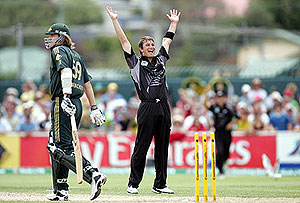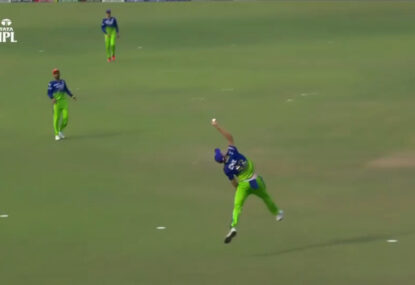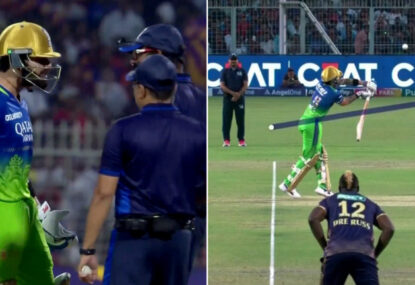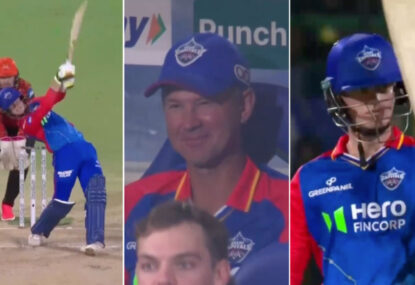
The alternative, subcontinental Chappell-Hadlee trophy
Another day, another Australasian player announces he is off to India to play twenty20 cricket and reap the rupees: last week it was Lou Vincent, this week comes the news that Jason Gillespie will be joining the procession.
Consider the following lineups, listed in batting order, that would make for a compelling Chappell-Hadlee series:
New Zealand: Nathan Astle, Lou Vincent, Stephen Fleming, Scott Styris, Craig McMillan, Chris Cairns, Chris Harris, Adam Parore (wk), Shane Bond, Andre Adams, Daryl Tuffey, Hamish Marshall (12th man)
Australia: Justin Langer, Matthew Elliott, Michael Di Venuto, Jimmy Maher, Darren Lehmann, Damien Martyn, Adam Gilchrist (wk), Brad Hogg, Jason Gillespie, Michael Kasprowicz, Mick Lewis, Andrew Downton (12th man to be named)
What do all the players in these strong teams have in common, apart from being international cricketers? It is that they have all announced (most of them recently), or are soon expected to announce, some sort of retirement from Australasian cricket.
But this begs an obvious question: why are so many leading players suddenly retiring in droves? The answer lies in something that most of the above players also have in common: involvement in Indian twenty20 cricket tournaments, either the unsanctioned (“rebel”) Indian Cricket League or the “allowed” Indian Premier League (a curiously ignored fact is that the ICC is yet to officially sanction the IPL).
Here are the details on both scores, retirement and T20 involvement:
• Nathan Astle, Chris Cairns, Adam Parore: past retirement from all cricket, now playing ICL
• Craig McMillan, Shane Bond: recently allowed to pull out of (“retire” from) their contracts with NZ Cricket so as to play in the ICL
• Lou Vincent: walked away from his contract with NZ Cricket (without approval) so as to play in the ICL
• Hamish Marshall: did not accept a contract with NZ Cricket, instead opting to play as a local in English county cricket, and now also playing ICL
• Andre Adams, Daryl Tuffey, Chris Harris: not contracted to NZC but have been playing first-class cricket in New Zealand as ICL commitments allow
• Stephen Fleming, Scott Styris: IPL players (in contrast to their 10 countrymen above), with Styris having retired from test cricket and Fleming to retire from all international cricket at the end of March
• Michael Di Venuto, Mick Lewis, Andrew Downton: retirement from Australian first-class cricket (Di Venuto will continue to play for Durham), no reported links with India
• Damian Martyn: past retirement from all cricket, now playing ICL
• Matthew Elliott, Michael Kasprowicz, Jason Gillespie: recent retirement from Australian first-class cricket, now playing ICL
• Darren Lehmann, Jimmy Maher: recent retirement from Australian first-class cricket, considering ICL offers
• Brad Hogg: pending retirement from international cricket (undecided about first-class), thought to be considering an ICL offer
• Justin Langer: likely to retire soon from Australian first-class cricket (has already stepped down from one-day cricket), participated in IPL auction but then withdrew (because he wasn’t satisfied with his price? because he didn’t want to play as a teammate of Graeme Smith?)
• Adam Gilchrist: pending retirement from international and first-class cricket, playing IPL
While there is a lot of difference in the detail – who would have thought there were so many different ways to retire. The underlying commonality of India is clear.
What to make of all this?
In the case of New Zealand, the effect is obvious: the national team of a small country with limited depth has been gutted. This is because most of the players have signed to play with the ICL, which, due to political pressure from the omnipotent BCCI, makes them ineligible for international cricket (and possibly also all first-class cricket if the BCCI gets its way – the term “restraint of trade” does not seem to exist in its lexicon).
Sure, several New Zealand players were well retired before Indian money came on the scene (Parore, Cairns, Astle), and Indian money is by no means the only reason for all these departures: displeasure with coach John Bracewell is often rumoured to have been a reason, while age and burgeoning families (e.g. Fleming) has also been a reason.
But this doesn’t change that New Zealand has lost or is about to lose its best top-order batsman (Fleming), its form middle-order batsman of the last year (McMillan), its best bowler (Bond), and much of its cricketing depth: all this at least partially due to lucre of the Indian market.
Turning now to Australian cricket, at first it seems less affected: Martyn and Langer (and one might as well throw Shane Warne and Glenn McGrath in with them) retired well before Indian T20 tournaments were conceived. Gilchrist and Hogg are more recent, but age and declining form meant they were going to pull the plug soon anyway.
The rest of the Australian players are all on the wrong side of 30, and although they have all represented Australia (except for Downton, who only made it as high as Australia A), these halcyon days are all well behind them. So one might think their loss to Australian cricket is relatively unimportant.
However I believe this is a dangerous attitude, as now explained.
At the current ICC U-19 World Cup, Australia has been eliminated in the quarter-finals. The history of this event emphasizes that Australia’s raw talent is no greater than that of other major cricketing countries.
The only conclusion can be that the production line of talent for the Australian senior team is a result of superior development in Australia’s much-lauded domestic competitions. And there can be no doubt that a large contributing factor to the strength of these competitions is the presence of so many able, experienced, highly professional players such as Di Venuto, Downton, Maher and others listed above.
Of course there must always be turnover of the old for the new, but if the turnover is too great then there is a dramatic loss of professionalism, and consequently of standards. It has taken decades to build the Pura and Ford Ranger Cups into the quality competitions that they are.
Quite possibly this will be lost overnight as a result of the incursions of Indian chequebooks, which are removing more than a full team of hardened pros, i.e., over one-sixth of the competition! This is surely an unsustainable loss. Who is left to show Phillip Hughes how to build an innings, Peter Siddle how to bowl a side out, and Matthew Wade how to keep high his concentration with the gloves?
In summary, Cricket Australia might well have as much to worry about as does New Zealand Cricket.
All summer there have been vitriolic verbal battles between various Australian and Indian cricketers, but the last laugh may well go to the Indian authorities, whose recruiting of Australian players looks set to do more damage to Australian cricket than any ICC match referee ever could.
As for New Zealand, most cricket fans here sided with India in the “Bollyline” affair (i.e., the Harbhajan/Symonds “monkey” dispute), without consciously realising that behind their backs the BCCI’s hard line about the ICL was decimating the stocks of the Black Caps.
And try this for irony: Shane Bond wants to play for New Zealand and his ICL commitments were not to overlap with any New Zealand matches, but at the insistence of the BCCI, Bond cannot don the Silver Fern any more; however, it is looking likely that IPL commitments will see Vettori, Oram and McCullum miss the start of New Zealand’s upcoming tour to England, even though they are supposedly playing in the ICC-favored IPL that is not meant to compromise the Future Tours Program.
As one can say about so much of all this, go figure!




































































































